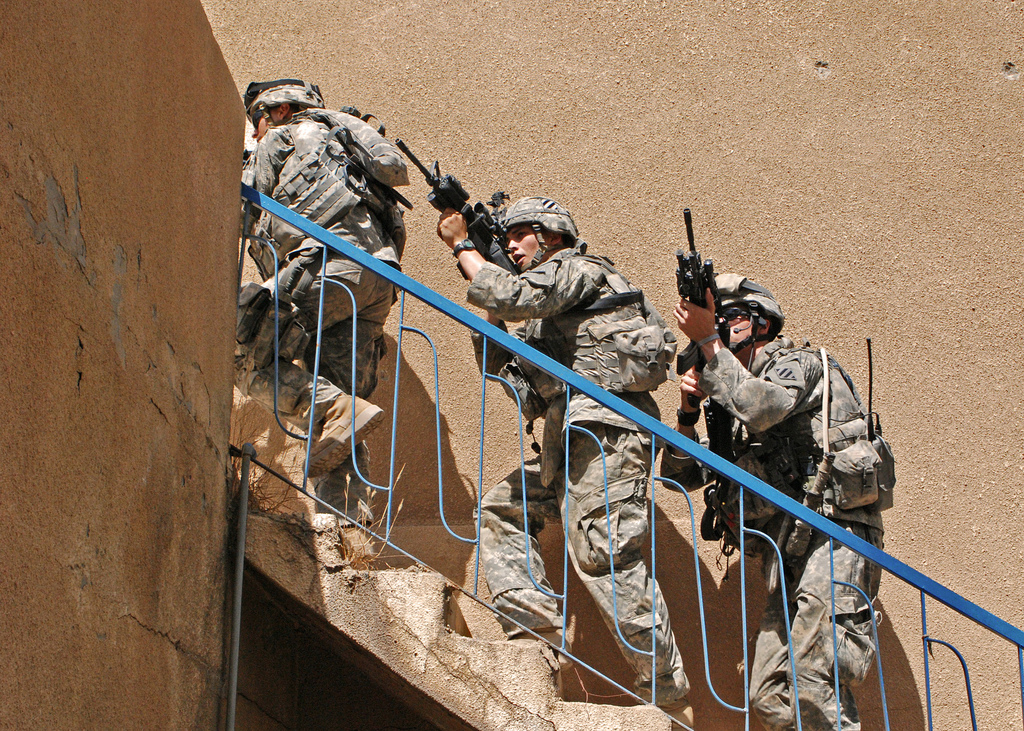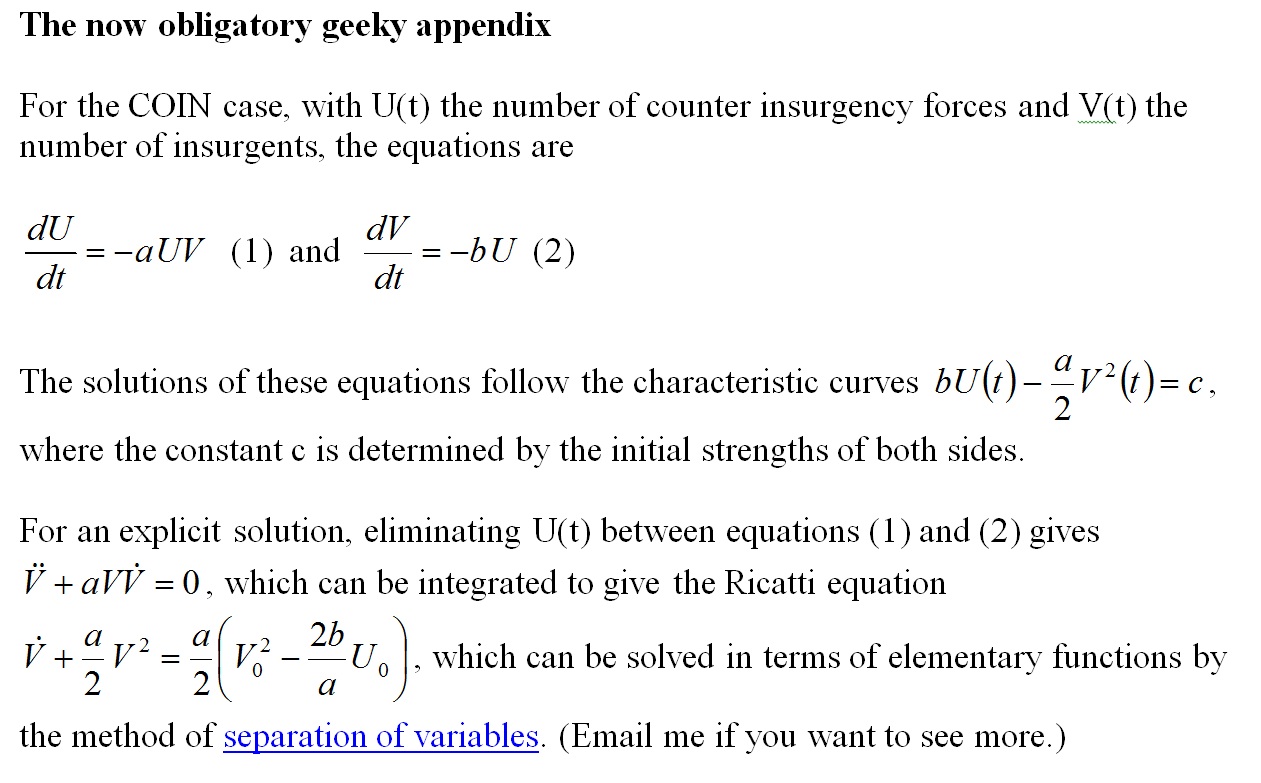 After last week's post on Lanchester equations and the applications of mathematics to warfare, I was asked several questions by interested readers. Is there a version of this analysis for counter-insurgency (COIN)? How useful are these models given the acknowledged simplification behind them? Why don't I get out more?
After last week's post on Lanchester equations and the applications of mathematics to warfare, I was asked several questions by interested readers. Is there a version of this analysis for counter-insurgency (COIN)? How useful are these models given the acknowledged simplification behind them? Why don't I get out more?
The third question is beyond the scope of this post, but after some thought and some (rusty) algebra, I think I can answer the first, and shed some light on the second in the process.
In COIN operations, there's an inherent asymmetry between the two sides that has to be captured by the mathematical model. The way I thought about it, the COIN (blue) forces basically present themselves as an area target as they spread over the landscape, allowing the insurgents to attack at a time and place of their choosing. So the blue force losses depend on both the number of blues and the number of insurgents (red), and the appropriate equation for blue losses is Lanchester's 'unaimed fire' equation (although the term 'unaimed' isn't accurate in this case). The red forces, on the other hand, have to be treated as precision 'point' targets that have to be precisely located and engaged. Their losses should be described by the 'aimed fire' equation. (See the appendix below if you want the grisly details.)
The results of solving these equations lead to a couple of observations that are broadly in accord with experience in COIN operations. It can take a large force to contain or defeat a small number of insurgents, and large forces can be worn down and suffer a disproportionate number of casualties at the hands of much smaller ones when there's an asymmetry in the engagement. Mathematically, it's the square of the number of insurgents that matters, compared to just the raw number of COIN troops—doubling the amount of insurgents makes the problem four times worse for the blue forces. And that also means that if insurgent forces are large enough, the blue forces can't win—or at the very least have to escalate their own efforts.
And we can use the model to study force escalation as well. The equations allow us to explore the efficacy of a 'surge' in COIN forces. A prediction of this model is that a blue force surge will have two consequences. First, the casualty rates of both sides will immediately increase—hardly surprising if there are more troops present in this kind of fight. But the model also predicts that the
total blue force casualties will be the same with or without the surge, but the surge will result in a
faster victory. Some indicative numbers are doubling blue force numbers results in victory in less than half the time.
Those predictions are borne out by some recent data. After the troop surge in Iraq early in 2007,
American casualties spiked dramatically to levels that hadn't been seen for almost three years. But the number of insurgents killed or arrested also increased, and by the end of the year American casualties were at their lowest post-2003 war levels and the overall security situation had
improved by every metric.
It might sound surprising, but I think those sorts of
qualitative insights are actually the best product from this sort of mathematical reasoning. I've deliberately avoided quoting numbers in this post for the simple reason that I don't think they're especially useful. The real world is much 'bumpier' than the smooth assumptions that underpin such a simple model. Quoting numbers gives the impression of precision, but little of the reality.
That's also true of the WWI land and air warfare examples I mentioned last week as well. One criticism I received was that there's a big difference between being on the attack and in a defensive posture in land warfare. The received wisdom is that you need to overmatch the defenders by three to one (or preferably more) to succeed—which is true. If you really wanted to, you could model that by making one side three times as effective as the other, and then make other more realistic modifications. That's the path towards simulations—a perfectly sensible thing to do if you need more detail and want numbers you can believe.
But simple models can still give you useful 'broad brush' answers with policy or doctrinal implications. The Royal Flying Corps benefitted by simply increasing the number of aircraft in its patrols in WWI. RAND's analysis of the impact of Chinese Air Force numbers poses a challenge for America's AirSea Battle concept. And before the Iraq surge, there was no shortage of expert commentators
saying that it wouldn't work. They were wrong, but Lanchester was right.
(Graphic below - click to enlarge.)

An interesting extension of this work would be to include a source term for insurgents, representing their ability to recruit from the larger civilian population. That's done
here, but note that they begin with coupled aimed fire equations instead—which I don't think accurately models COIN.
Andrew Davies is a senior analyst for defence capability at ASPI and executive editor of The Strategist.
Image courtesy of Flickr user The US Army. Print This Post
Print This Post After last week's post on Lanchester equations and the applications of mathematics to warfare, I was asked several questions by interested readers. Is there a version of this analysis for counter-insurgency (COIN)? How useful are these models given the acknowledged simplification behind them? Why don't I get out more?
After last week's post on Lanchester equations and the applications of mathematics to warfare, I was asked several questions by interested readers. Is there a version of this analysis for counter-insurgency (COIN)? How useful are these models given the acknowledged simplification behind them? Why don't I get out more? An interesting extension of this work would be to include a source term for insurgents, representing their ability to recruit from the larger civilian population. That's done here, but note that they begin with coupled aimed fire equations instead—which I don't think accurately models COIN.
An interesting extension of this work would be to include a source term for insurgents, representing their ability to recruit from the larger civilian population. That's done here, but note that they begin with coupled aimed fire equations instead—which I don't think accurately models COIN.